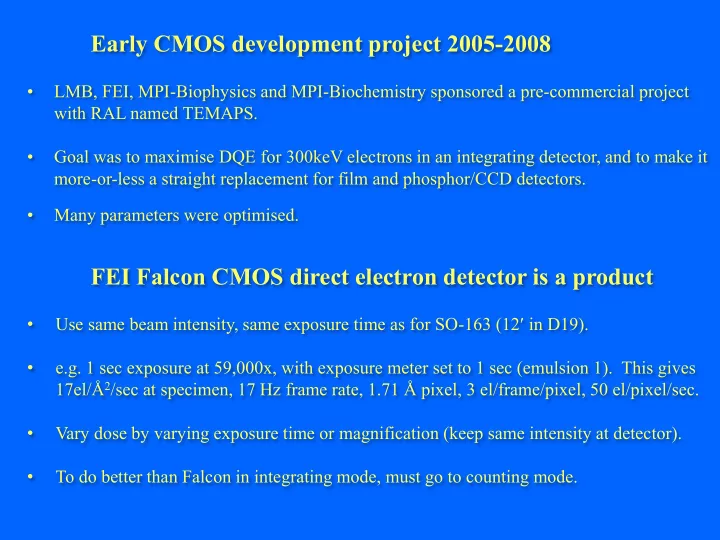

Early CMOS development project 2005-2008 • LMB, FEI, MPI-Biophysics and MPI-Biochemistry sponsored a pre-commercial project with RAL named TEMAPS. • Goal was to maximise DQE for 300keV electrons in an integrating detector, and to make it more-or-less a straight replacement for film and phosphor/CCD detectors. • Many parameters were optimised. FEI Falcon CMOS direct electron detector is a product Use same beam intensity, same exposure time as for SO-163 (12 in D19). • • e.g. 1 sec exposure at 59,000x, with exposure meter set to 1 sec (emulsion 1). This gives 17el/Å 2 /sec at specimen, 17 Hz frame rate, 1.71 Å pixel, 3 el/frame/pixel, 50 el/pixel/sec. • Vary dose by varying exposure time or magnification (keep same intensity at detector). • To do better than Falcon in integrating mode, must go to counting mode.
DQE( ) = DQE(0)*MTF 2 /NTF 2 Meyer & Kirkland (2000) De Ruijter (1995)
(Pre-Falcon) McMullan et al (2009a, 2009b, 2009c) Ultramicroscopy
From FEI Falcon brochure
LMB Falcon mounting and single frame acquisition system – Greg McMullan
LMB report on backthinned Falcon May 2011
Electron counting with Falcon Single electron event processed images – backthinned Falcon Best region, area of 280x280 pixels single frame sum of 26,000 frames
Backthinned Falcon - 1000 mesh grid shadow pattern – single electron comparison integrating mode centre-of-gravity centre-of-gravity interpolated Integrating mode Counting mode “Super - resolution” mode
Backthinned Falcon -300 keV 1 s4 s2 2 theoretical s4 MTF s1 0.8 Integrating 0.6 DQE 0.4 0.2 0 0 1 2 0.5 1.5 Fraction of Nyquist
T12/SO-163 Krios/Eagle Polara/BT-Falcon 120kV 80kV 300kV
Acknowledgements • Wasi Faruqi MRC-LMB • Greg McMullan MRC-LMB • Shaoxia Chen MRC-LMB • Renato Turchetta RAL/STFC • Nicola Guerrini RAL/STFC • Gerald van Hoften FEI
Recommend
More recommend